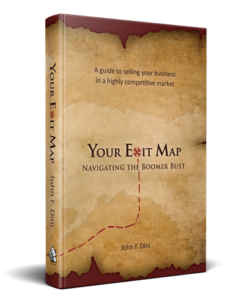Subordinated debt can be a key consideration in any sale transaction. Whether you are contemplating a sale to a third party or an internal transfer to employees, the topic of taking second place to a lender will likely come up.
 If an outside buyer is financing the purchase, seller notes can be considered as part of a down payment, but any bank will require it to hold second priority to their loan. If the Small Business Administration is involved, they will usually demand that the seller assume some of the risk with a secondary loan. In an internal sale, that will be a requirement.
If an outside buyer is financing the purchase, seller notes can be considered as part of a down payment, but any bank will require it to hold second priority to their loan. If the Small Business Administration is involved, they will usually demand that the seller assume some of the risk with a secondary loan. In an internal sale, that will be a requirement.
Risk vs. Reward
As a business owner, you make decisions about good risk and bad risk every day. You extend credit to customers, and spend money on marketing or expansion based on your projection of a future payoff. Subordinated debt is just another risk/reward consideration.
It may allow you to get a higher price (eventually) than demanding an all-cash deal. It can also be the deciding factor in qualifying a buyer for outside financing for the majority of the purchase.
In an internal sale, subordinated debt is frequently a trade-off for time. An exit date may be your choice, or driven by outside factors such as health, family needs or increased competition.
When your target departure date is close, especially if it is two years or less, it is difficult to transfer enough equity to employees for them to qualify for 100% outside financing. The percentage of the risk that you are willing to bear has a direct impact on what another lender will do.
If you need to leave in less than a year, financing the entire transaction might be your only choice.
Qualifying Subordinated Debt
Some brokers tout the tax advantages of installment sales with 100% seller financing as the best way to sell a business. In my experience, it is more likely to attract unqualified buyers. No reduction in tax rates comes close to the advantages of cash in your pocket.
It’s true that unsecured loans usually carry a higher interest rate due to the lack of security. That might be tempting, but no interest rate is attractive if you don’t get paid.
As a lender, you have the same interest in choosing a qualified buyer as the bank. Using subordinated debt to serve your purposes is a valid tactic. Using it simply because you are the lender of last recourse is probably not.
 That approach helped the company grow with a balanced customer base. BVA has a presence in food testing laboratories, water and wastewater plants and the Texas oil fields, rather than the typical dominance of doctors and hospitals for their type of business.
That approach helped the company grow with a balanced customer base. BVA has a presence in food testing laboratories, water and wastewater plants and the Texas oil fields, rather than the typical dominance of doctors and hospitals for their type of business.
 For many owners, their biggest concern in an exit plan is maintaining control. Whether they seek to sell to employees, family or a third-party, there is a fear that, once started, the process will have its own rules and momentum.
For many owners, their biggest concern in an exit plan is maintaining control. Whether they seek to sell to employees, family or a third-party, there is a fear that, once started, the process will have its own rules and momentum. In fact, when the survey results were broken down, they discovered that 85% of 60 year old owners expected to sell in five years. Among 65 year olds, 85% expected to sell in five years. Among 70 year olds, you guessed it, 85% expected to sell in five years.
In fact, when the survey results were broken down, they discovered that 85% of 60 year old owners expected to sell in five years. Among 65 year olds, 85% expected to sell in five years. Among 70 year olds, you guessed it, 85% expected to sell in five years.